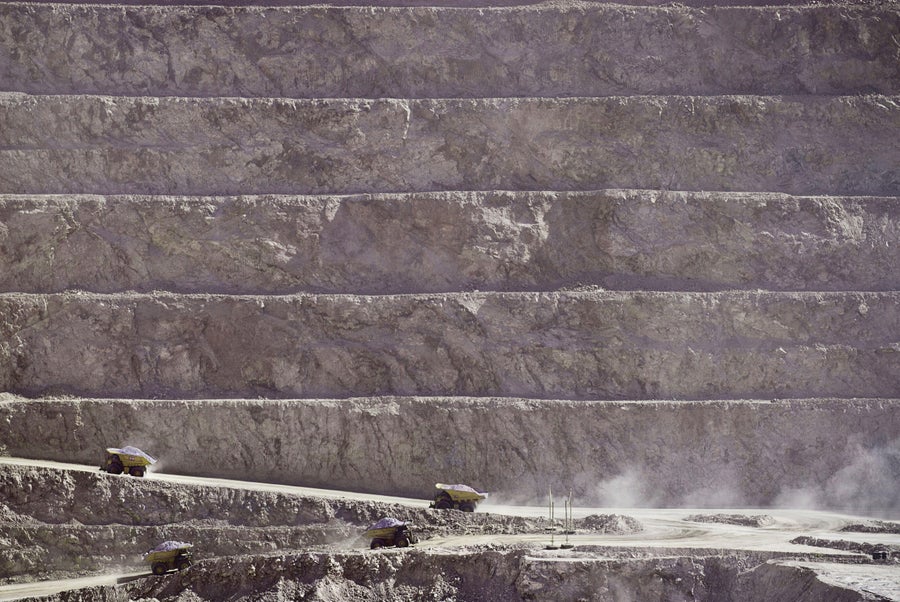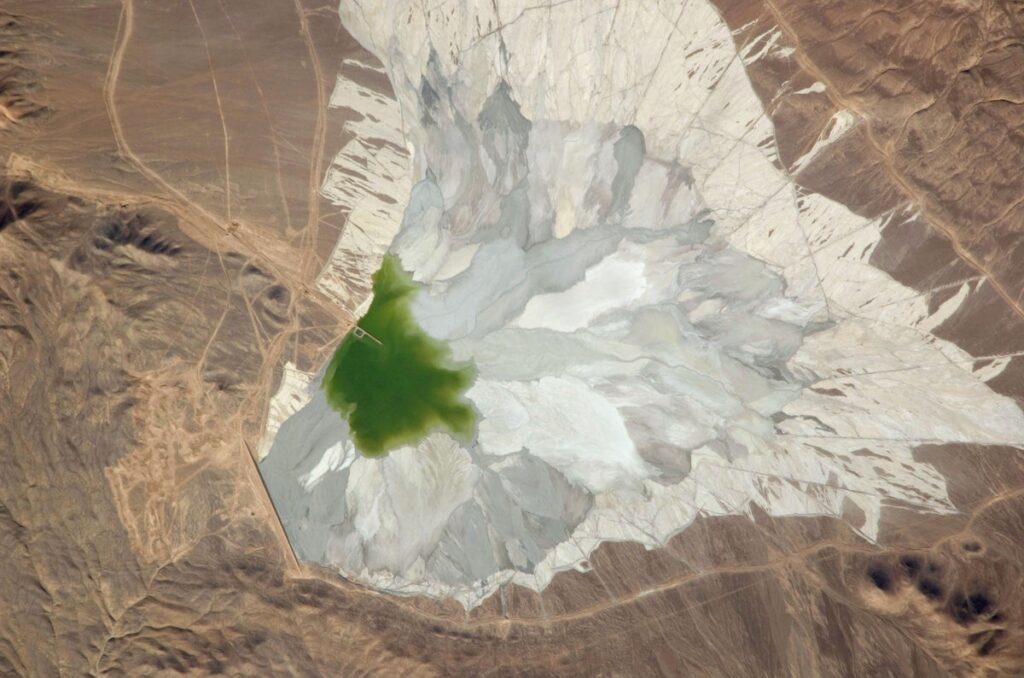October 1, 2025
5 min read
Meet the Microbes That Munch Mountains of Mining Waste
Biomining uses engineered microbes to harvest critical minerals
Escondida Mine, located in Chile’s Atacama Desert. The copper-bearing waste is poured into the impoundment area as a liquid (green region at image center) and dries to the lighter tan and gray color.
Science History Images/Alamy Stock Photo
At the northern edge of Chile’s Atacama Desert sits a pile of rocks that’s so big that you can see it from space—and it’s teeming with invisible activity. Billions of microbes are hard at work dissolving compounds in this giant mound of crushed ore from Escondida, the biggest copper mine on the planet.
“Microbes are the world’s oldest miners,” says Liz Dennett, founder and CEO of the start-up Endolith Mining, based near Denver, Colo. “They’ve had billions of years to become incredibly good at eating rocks.”
Scientists at Endolith and elsewhere are engineering microbes to get even better at this process, called biomining—to work faster, extract more copper and even pull out other kinds of minerals. Endolith tests different microbes to see which are most fit for the job and then exposes them to harsh conditions to further strengthen them. “Think of it like a superhero training camp,” Dennett says. In May the company’s engineered microbes demonstrated copper extraction superior to microbes found in nature; its first field deployments are scheduled for later this year.
On supporting science journalism
If you’re enjoying this article, consider supporting our award-winning journalism by subscribing. By purchasing a subscription you are helping to ensure the future of impactful stories about the discoveries and ideas shaping our world today.
Biomining, if it can be scaled up, could make it possible to decrease reliance on global supply chains, which are becoming ever more fragile. “If we can make biomining work, we can break the monopoly that states like China have on critical metals,” says Buz Barstow, a biological and environmental engineer at Cornell University. Barstow is leading a project called the Microbe-Mineral Atlas that catalogs microorganisms, their genes and how they interact with minerals. The project’s goal is to build genetically engineered microorganisms that can effectively mine critical metals.
As many countries transition to renewable energy, they will require fewer fossil fuels but more minerals such as lithium, cobalt, copper, nickel and zinc. These are not only needed for wind turbines, solar panels and batteries; they’re also crucial for the laptops and cell phones we use every day. Copper demand, in particular, is set to skyrocket. Forecasts show we’ll need more copper in the next 30 years than has been mined throughout all of history. Much of the low-hanging fruit—that is, high-grade ore—has been picked, and mines have to work a lot harder than before to get the same quantity.

Trucks hauling earth from Escondida.
Cavan Images/Alamy Stock Photo
Conventional mining techniques are resource-intensive, expensive and harmful to the environment. After using explosives and heavy machinery to extract ore from the earth, mining companies must isolate and purify the minerals in question. Often, that means breaking chemical bonds that keep minerals bound to sulfur in sulfide ores. This is most commonly done using heat through a process called smelting or acid through a process called leaching. Smelting requires extremely high temperatures, reached by burning fossil fuels or using a lot of electricity. On top of the carbon dioxide emissions this generates, burning sulfur produces toxic sulfur dioxide gas. Acid leaching, meanwhile, carries the risk of acid mine drainage, where fluids contaminate rivers or groundwater and harm the surrounding ecosystem. The sulfuric acid used for this process can cause harm before it even reaches mines. “Production of sulfuric acid is very nasty,” Dennett says. “There’s a lot of secondary and tertiary effects on the environment.”
Microbes can do the same work as heat and acid, but their cost and environmental impact are much lower. “Microbes use at least six different mechanisms for biomining,” Barstow says. The most common is an oxidation-reduction reaction, or redox reaction, in which microbes break the chemical bonds in a sulfide ore by “eating” their sulfur and iron. This releases the minerals in the ore, breaking them down until they can dissolve in water. The mineral-rich solution is collected in a pond after it is drained from the rock and is then exposed to solvents and electricity that attract the minerals like a magnet while leaving water, acid and impurities behind.
The microbes still need a small amount of sulfuric acid to kick-start the process of breaking down the ore. Piles of rock such as the one at Chile’s Escondida mine—called heap leaches—are sprayed with an acid-water mixture that only needs to be added once because microbes make more acid naturally as they break the ore’s chemical bonds. “Replacing [most] sulfuric acid is a big economic benefit, as it can often be the largest operating expense for a mine,” says Sasha Milshteyn, founder of Transition Biomining, a company that analyzes the DNA of microbes found in ores to develop custom additives for increased copper recovery.
Though the process avoids toxic gas emissions, uses less energy and water than conventional methods and minimizes hazardous chemicals, it has its limitations. It’s slower than traditional mining: while smelting can take hours to days, and acid leaching takes days to weeks, microbes do their work over several months. They’re sensitive to pH, temperature, and moisture levels and can be killed off or slowed down by changes in any of these. And they still produce acidic solutions that need to be contained and treated. As Barstow puts it, “Biomining won’t be an environmental panacea; it will just be quite a bit better than what we do now.”
The real promise of biomining is that it can squeeze more out of rocks than conventional methods do. “Modern mining technologies ‘skim the cream’ of economically valuable metals from a deposit and leave everything else behind in [waste rock called] tailings,” Barstow says.
That waste is worth far more than it usually gets credit for. A study recently published in Science found that recovering the minerals in waste from existing U.S. mines could meet nearly all of the country’s critical mineral needs; recovering just 1 percent would substantially reduce import reliance for many elements. “If large mines just added additional recovery circuits to their process, this could bring needed minerals into production relatively quickly,” says the study’s lead author Elizabeth Holley, a mining engineer at the Colorado School of Mines.
Copper mine waste can hold bits of tellurium, cobalt or zinc; coal ash can contain lithium, manganese and rare earth elements. The quantities are too small for conventional mines to bother with, but they’re not too small for microbes. Besides being used in heap leaches or pumped straight into the ground, microbes can be applied directly to waste streams, where they can pull out tiny amounts of minerals that can add up to be significant.
Microbes may be the world’s oldest miners, but biomining as a technology is still new, Milshteyn notes, and doesn’t yet leverage the full complexity of microbial ecosystems. “The heaps that perform best in the field have thriving ecosystems of diverse microbes working together,” he says. “I think the next generation of biomining has to contend with that complexity.”

